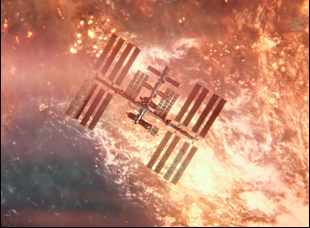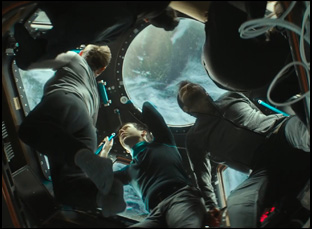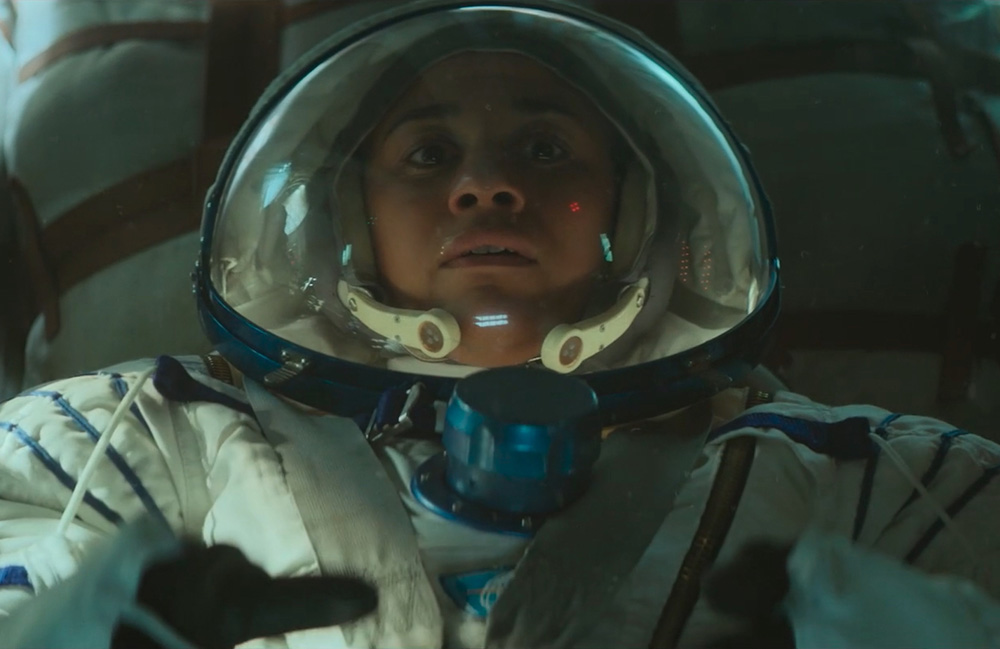“No one knows what kind of sleeper they’ll be when they get up here,” Gordon (Chris Messina) tells Kira (Ariana DuBose) during her first night aboard the Soyuz Rocket in “I.S.S.,” and while the likelihood of getting any shut-eye after the excitement of joining her crew after an arduous journey across the galaxy is a longshot, there are other things keeping her awake on the international space station. At first, it would seem like she’s simply found her way into a rowdy college dorm where there are half-played chess games on the side of the walls and even a few bottles of booze have made their way onto the shuttle, thanks to her Russian compatriots Nikolai (Costa Ronin), Alexi (Pilou Asbæk) and Weronika (Masha Mashkova), who the American has been brought up to work alongside with her fellow countryman Christian (John Gallagher Jr.), to conduct scientific studies about organ regeneration. However, even after a night of bonding over a crew member’s birthday, any camaraderie comes to an end once Kira witnesses a volcano-like eruption on earth that’s big enough to be seen from miles above, leaving them all to wonder what’s going on below and despite a strict policy of avoiding any talk of politics, it inevitably finds its way onto the ship with seemingly as much capability to kill as the Xenomorph in “Alien.”
Even though director Gabriela Cowperthwaite has never shied away from wading into murky geopolitical situations, she’s usually maintained a similar dividing line in her own work, presiding over sprawling investigations in her nonfiction films such as “The Grab” about countries increasingly buying up natural resources from one another, and “Blackfish,” which put the spotlight on the inhumanity of keeping killer whales as theme park attractions around the world, while segueing to dramas where the concerns of the larger world are made to seem small in comparison to the intimate struggles of the characters in “Our Friend” and “Megan Leavey,” where free of documentary constraints she has delved deep into the human condition. As peace begins to crumble between the American and Russian crews aboard the I.S.S., with both instructed by their respective ground control to take authority over the ship, the director finds her own worlds colliding as she makes her first proper thriller, working from a sharp script by Nick Shafir that plays out like a wicked game of telephone where in the aftermath of the start of what could possibly be World War III, a little more trust in each other is lost with each conversation as the once-cordial crews wonder about the motives of the other.
Naturally, one can’t help but think of the ongoing invasion of Ukraine as fear takes hold in the skies, but “I.S.S.” is just as apt to offer escapism when any seeds of doubt amongst the astronauts allow a taut thriller to blossom, turning the corridors of the shuttle into a haunted house where one never knows what’s just around the corner. After the film’s premiere at Tribeca, Cowperthwaite spoke about this unexpected twist in her own filmography, the formally freeing opportunity to direct a genre film despite the literal harnesses that came with portraying zero gravity and having the confidence in her cast to tell a story about where distrust can lead.

I know they seem so disparate, but there’s some major similarities in that, like I love deep character studies. I love thrillers. And when you look at “Blackfish,” it was a thriller, and I tried to make “The Grab” and “Children of the Underground” like a thriller, so I want to push that genre, especially in things you don’t expect. I love that edge of your seat feeling, but I also love just deep character [studies where] a movie being driven by characters doing what they would naturally do and the reason this film moves in this direction is because someone is who they are. So that’s cross cuts all the films too. I also like films that make you think a little bit about maybe how you’re doing life and who we are and how we can maybe do maybe do life better. I saw the potential for those types of things in the script of ISS, so, there are some similarities, even though this one seems like a departure for sure.
What got you excited about “I.S.S.”?
I wanted to just play in a completely different playground, and I’d never had that many VFX in a movie. There were over a thousand in this film, so I wanted to push myself to do those types of things. But also just this story was cool and the plot did what a cool plot-driven film can do. The idea that these people are all up there together — and on the I.S.S., in reality this is a place where different nationalities have played well together time immemorial, so the idea that they can be asked to do the unthinkable, the challenge of all of that was how you humanize each other and [ask] should you be actually be full of distrust? Those themes were really compelling to me because I think we’re seeing them in the world all the time.
You can’t help but think about the invasion of Ukraine, given the Russian component of this. Was that on your mind making it?
It didn’t because it hadn’t happened yet. Something so crazy about it is that we’ve had this really complicated, very charged relationship with Russia, but it wasn’t necessarily 100% adversarial. There were a lot of questions and distrust, so that was baked in [to the script] as to how we were feeling about this country, and it made sense to have Americans and Russians on board on the I.S.S. together, contending with these feelings, but in terms of an all-out war, that just hadn’t happened yet. We knew there was troops from the documentary I had worked on, “The Grab,” believe it or not, Russian troops encroaching, and we addressed that directly in “The Grab,” like “Wait a second, is there going to be a war breaking out?” But then I get this script that had nothing to do with Ukraine and nobody knew it was going to happen, but suddenly it starts unfolding.
Part of it was really hard because, as a narrative fiction film, you don’t want to make a commentary on something that’s actually unfolding and is really, really dangerously charged. So we had pause for a second, like “What are we doing here?” But then we really looked at it, and it was just like, “Okay, the script is about the people and about human beings faced with an unthinkable situation, and how do we continue to humanize each other after that? Can we truly walk in another person’s shoes?” Those were the types of things that I think the movie speaks to are the little people who were kind of asked to absorb the blows when conflicts arise, and I feel like that is something that will hold true no matter what happens in the world.

That was what I wanted to tease out — the notion that we understood that the moment I start distrusting you, you inevitably stop trusting me. That’s just the way that works in human beings, so there’s a line that I put in, like, “Why would you trust me?” And seeing the best in one another, humanizing each other is the reason why we can come together [where it’s like my] success does not depend on you not doing well. It’s actually the opposite, so I wanted that to be very front and center, but also you see how fear gets in the way [where the characters feel] I can’t bank on you being a good person. That’s so much about human interaction, and in the world’s infrastructure [more broadly] and how we look at other countries [with] misinformation and distrust. If we keep going down that road, then we’re looking down some dark roads and we’re looking at it now.
You’re pulling off all this high drama in zero gravity, and I remember the days when Ron Howard was saying for “Apollo 13, they would have to film in 10-minute bursts up in the air. What was it like to pull this off?
Once I saw what happens in those zero gravity capsules [where] 70% of the people are just sick the entire time —it’s just so hard on your body — [I thought we’re] definitely not doing that. It’s also a billion dollars, for two minutes [of screen time] or whatever, so I had to trust the stunts team and [the popular way to do it is to] put the actors on these contraptions that are almost like a seesaw where you’re leaning down and your body is held [in place] and then VFX and all that stuff [makes it] look like you’re just flying in the air. Those to me didn’t look like zero gravity, unfortunately. It just looked stiffer. So the only way to do it was really these tethers, harnessing people to these gantries and it’s so uncomfortable, but it looked the most real. And of course that’s my entire thing. I want everything to feel authentic. So the actors went along with it, and they put themselves in these crazy uncomfortable situations on a day-to-day basis to be able to get that look, but I just happened to have this bang-up crew of actors who were like I will settle for nothing less. I got lucky.
It’s a real lived-in spacecraft as well, and the production design not only reflects the history of the shuttle and the people who inhabit it, but must’ve been interesting to figure out how to embed lights in it as well.
The first thing that [the producers] Mickey Liddell and Pete Shilaimon, who did my first narrative feature “Megan Leavey,” asked when they brought it to me was, “How do you see this?” And the first thing I did was find all these pictures of the real space station and they were so compelling to me — that human look to it. It’s layered and it’s messy and you could just lose a packet of mustard or Tang — whatever we pretend that astronauts still drink — and it just does its thing [floating around in] zero gravity. If you don’t grab it, it’ll embed itself somewhere and you will never find it, so picture this happening for decades. So there’s layers of all this. I love that messiness. I love the humanness. And when I brought those pictures [to the crew], I said, “Okay, I don’t want to do that clean cut sci-fi [where] everything is metal and aspirational and perfect. I would love to just make this look like it looks.”
Then being able to light inside those [spaces] and also [get] the creepiness, it’s human in a lot of ways [because it’s] incredibly creepy when you’re looking down these corridors and it’s so destabilizing. You lose your bearings constantly. Up is not down, and it’s so weird and scary when you look at it. Jeff Wallace was my production designer who just nailed that realistic look, and then Nick Matthews, my DP, got the whole [vibe] of the vodka scene where we can make this warm and familial and do little fake candles like they do, and then we [could] do practical lighting throughout the set, but also make it so creepy. We can make this feel like the last place you’d ever want to be, so playing with both of those [tones] with Nick was so much fun.
There’s a great scene in which Weronika is suspended in mid-air, experiencing an emotional paralysis that you can really inject genre elements into. Was that fun to apply your instincts while trying something new in that way?
It’s so much fun, just watching her break and I really wanted [Masha Mashkova] to feel that and to be in this room, be tethered, and just get into that space, and we’ll do the rest. [Masha] is so athletic in her physicality and her ability to be in pain in this tether informed everything she did as an actor right then and it’s so, so beautiful what she does there because you’re really inside somebody’s head. That was really all her and this is what happens when you when you cast actors this good. There’s times where it’s just like, “Okay, we’ve got everything over here. I can tell you to just X, Y, and Z, but I know whatever I ask of you, you’re gonna do 85,000 times more.” And that scene, I think we were all just like jaws on the floor when we saw that.
“I.S.S.” will screen at Tribeca Festival on June 13th at 8:30 pm at AMC 19th St. East and June 18th at 8:30 pm at SVA Theatre.




